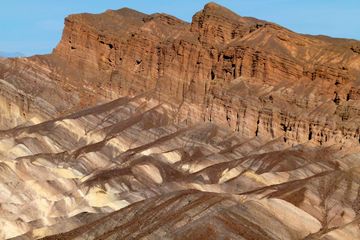Sedimentary rock

Sedimentary rock is rock that is formed over a period of time as a result of accumulation of sediment in one area. There are three main types of sedimentary rocks:[2]
- Classic sedimentary: Formed from mechanical weathering of debris
- Chemical sedimentary: Formed when dissolved minerals precipitate from a solution
- Organic sedimentary: Form from the accumulation of plant or animal debris
Sedimentary rock is very common. This type of rock covers around three quarters of the land area, mostly on the ocean floor. In some places, such as at the mouths of rivers, sedimentary rock can be as much as 12 000 meters thick.[3] Some examples of common types of sedimentary rock are sandstone, limestone, chalk, and clay.[4]
Sedimentary rock is important to the energy sector because this is the type of rock that forms fossil fuels. For example, sedimentary rocks such as shale can contain large amounts of kerogen that can be extracted to obtain oil. This type of shale is known as oil shale. Natural gas can also be trapped in shale, and this type of gas is known as shale gas. As well, sedimentary rock is a common rock found in oil reservoirs.
Formation
Sedimentary rock is formed over the course of millions, even billions of years. In fact, geologist believe that sedimentary rock was forming three and a half billion years ago.[3] The formation begins when different types of sediments settle in the bottom of a lake, sea, or ocean. If not in a body of water, sedimentary rock can form as a result of the pressure of increased compression of sediment on land over the course of millions of years.[4]
The sediment contained in sedimentary rock tends to come from rocks that have been eroded by rivers or ice. Larger rocks are broken down into small pieces that are carried away and moved to wherever the sediment is collecting. As layer after layer of sediment is deposited, the pressure on this sediment increases. Over the course of millions of years, this increasing pressure causes the lower layers of sediment to be compressed into sedimentary rock. The type of sediment deposited will change the type of sedimentary rock created. For example a sand deposit turns into sandstone, while silt becomes shale.[3]
After thousands of years, sedimentary rock is formed once layers of compact rock mold together. Water trickles slowly through these layers, depositing mineral cement and fusing the layers of rock. These layers vary in composition and texture.[3]
References
- ↑ Wikimedia Commons. (September 17, 2015). Sedimentary Rock Layers [Online]. Available: https://upload.wikimedia.org/wikipedia/commons/0/00/Sedimentary_Rock_Layers_Zabriskie_Point_Death_Valley_USA.jpg
- ↑ Geology.com. (September 17, 2015). Sedimentary Rock [Online]. Available: http://geology.com/rocks/sedimentary-rocks.shtml
- ↑ 3.0 3.1 3.2 3.3 Government of Prince Edward Island. (September 20, 2015). Sedimentary Rock [Online]. Available: http://www.edu.pe.ca/southernkings/sedimentaryec.htm
- ↑ 4.0 4.1 BBC GSCE Bitesize. (September 20, 2015). Sedimentary Rock [Online]. Available: http://www.bbc.co.uk/schools/gcsebitesize/geography/rock_landscapes/classification_rocks_rev4.shtml

